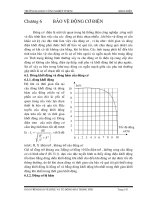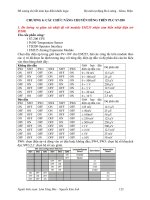Experiment 6 sorption
Bạn đang xem bản rút gọn của tài liệu. Xem và tải ngay bản đầy đủ của tài liệu tại đây (95.47 KB, 4 trang )
CIVL375: Experiment 6
REMOVAL OF ORGANIC CONTAMINANTS BY ACTIVATED CARBON
Introduction
Adsorption is a process which involves the interphase accumulation or concentration of
substances at a surface or interface. Adsorption may be a result of Van der Waals forces
acting on the solid surface (physical adsorption) or due to chemical interaction between
the solid and the absorbed surface. Adsorption equilibrium is established when the
concentration of the contaminant remaining in solution is in dynamic balance with that at
the surface.
C
S
Several models have been established to describe adsorption behavior
1. The Linear model
S=KC
2. The Fruendlich model (nonlinear sorption)
S= k Cn
3. The Langmuir behavior
1 1 1 1
= +
S b ab C
where K, k, n, a, and b are constants usually determined in the laboratory for each
sorbate-sorbent combination.
Objectives
The objectives of this exercise are to:
1. become acquainted with batch reactors and determine the equilibrium sorption
behavior that best describe the interaction of methylene blue with activated
carbon in a batch reactor.
2. become acquainted with packed bed reactors and determine the amount of carbon
needed to treat 120 m3/day of an industrial wastewater containing methylene blue
at a concentration of Co. Assume the allowable concentration before discharge of
the wastewater is 0.2Co.
Sample Identification
A synthesized sample containing methylene blue is generated for this exercise.
Materials and Reagents
Glass bottles with caps
Glass column with end fittings and tubes
Pump
Spectrophotometer
Shaker
Methylene blue
Actived carbon
Procedure
1. Construct a calibration curve for the spectrophotometer using a wavelength of 660 nm.
This is usually accomplished by measuring instrument response for different prepared
concentrations of contaminant (standards).
Table: Data to construct calibration curve for methylene blue
Std. #
Concentration mg/l
response
1
0 blank
2
3
4
5
6
2. Determine the initial concentration (Co) of methylene blue in the solution to be treated.
3. Conduct a batch sorption isotherm study
Use 7 bottles to conduct a batch sorption isotherm study. The initial concentration of
the contaminant and volume of liquid are kept the same but the mass of activated
carbon will be varied from 0 (blank) to a maximum value given by the instructor.
Table: Data to construct sorption isotherm for methylene blue
Bottle # Volume of
Mass
Initial
Final
solution V, carbon concentration response
ml
M, (g)
Co, mg/L
1 blank
2
3
4
5
6
7
Final liquid
concen
tration
C, mg/L
Concentration
on
carbon
S, mg/g
0
The equilibrium concentration on the carbon is determined by mass balance:
(Mass of contaminant in the liquid + mass of contaminant on the carbon)initial =
(Mass of contaminant in the liquid + mass of contaminant on the carbon)final
(C×V + S×M)initial
=
(C×V + S×M)final
Co×V + 0
=
Cfinal×V + S×M
4. Plot the sorption isotherm and determine the best-fit model (based on the value of r2).
5. Perform a column experiment.
A. Determine the following characteristics related to the column conditions
•Length of the column (L)
•Internal diameter of the column (D)
•Mass of carbon (M)= Wt. column filled with carbon – Wt. column empty
•Flow rate (Q)
B. Inject a solution containing methylene blue at a concentration of Co with a flow
rate Q. Use stop watch and mark this as zero time.
Collect samples from the other end of the column (effluent samples) and
determine the Cout at different time intervals.
Table : Effluent concentration versus time
t
response
concentration t
response
concentration
C. Generate a breakthrough curve for methylene blue.
The y-axis for this curve is Cout/Co and the x-axis is time. From the graph
determine the time required to reach to an allowable effluent concentration of
0.2 Co.
D. Use scale-up approach (as presented in the lecture notes) to estimate the
amount of carbon needed to treat 120 m3/day of this wastewater to meet the
above allowable effluent concentration.
Note that due to time limitations, the column experiment is not commonly performed.
Requirements:
1. Fill out the provided experiment data sheet and carry out the required calculations.
2. If you are requested to submit a report of this experiment then your report should
contain (a) an introduction that ends with the objective (b) methodology including sample
identification (c) results and discussion (d) conclusion (e) references and (f) an appendix
that contains the filled data sheet.
CIVL 375: Experiment 6 Data Sheet
REMOVAL OF ORGANIC CONTAMINANTS BY ACTIVATED CARBON
Name
ID
Experimental Conditions
Experiment date
Sample identification
Initial concentration of
methylene blue (mg/l)
Mixing time (day)
Instrument Calibration
Standard No.
1
2
3
4
Batch Sorption Isotherm
Bottle
Activated carbon
No.
mass (g)
1
2
3
4
5
Concentration, mg/l
Volume of methylene
blue solution (ml)
Response
Response at
equilibrium
Concentration at
equilibrium (mg/l)
Required Calculations
1. Construct a calibration curve for the detection of methylene blue using the spectrophotometer.
2. Plot the equilibrium solid concentration versus the equilibrium liquid concentration.
3. Determine the appropriate sorption model.









